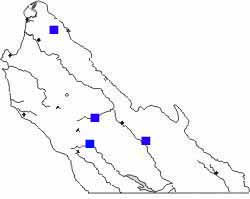| |
|
|
|
WESTERN
PONDHAWK
|
|
Erythemis
(simplicicollis) collocata
|
|
Western Pondhawk is well named.
It is a medium-sized species that typically hunts, or defends
territories, around the edges of ponds and lakes. Given its size, it
sometimes hunts smaller odes.
|
|
|
|
Photo (above) 5
Aug 2006 Arroyo Seco Lakes
Photo (below) 12 May 2007 N fork San
Antonio River
|
| Western Pondhawk is quite similar in
appearance to Blue Dasher, and the two often are found together, but
the pondhawk is a bit larger. All ages and sexes of the pondhawk have a
green face (right). Male pondhawks have dark blue eyes. Blue Dasher has
a white face and green eyes. Another difference is that Western
Pondhawk often perches on the ground (as above) or on floating
vegetation; the Blue Dasher perches higher. |
|
|
 A female Western Pondhawk is
mostly pale green in color. Immature males start out like
females (left). Manolis (2003) describes the changing color like this:
"The
males take a few weeks to change color; first the abdomen becoms blue,
then the front of the thorax, and lastly, the sides of the thorax." A female Western Pondhawk is
mostly pale green in color. Immature males start out like
females (left). Manolis (2003) describes the changing color like this:
"The
males take a few weeks to change color; first the abdomen becoms blue,
then the front of the thorax, and lastly, the sides of the thorax."
Females ovipost in the pond by rapidly dipping the
tip of her abdomen into the water, often with a 'guarding' male
hovering above.
Photo (left) 15 Apr
2007 Gibson Ranch Co. Park, Sacramento Co.
|
| Pondhawks are a diverse genus of 11 species
widely distributed in the Western Hemisphere (Manolis 2003). This is
the only species to reach California. Many authorities consider it
conspecific with Eastern Pondhawk Erythemis simplicicollis.
Thus that species name is placed in parentheses above. Visually, the
terminal appendages are white on Eastern Pondhawk and black on Western
Pondhawk, but apparently there is overlap and/or introgression. |
|
 The map shows the locales at which Western
Pondhawk has been recorded so far. All are ponds with reedy edges or
slow moving backwater marshes. It likely occurs in similar habitat
throughout the MTY lowlands. The map shows the locales at which Western
Pondhawk has been recorded so far. All are ponds with reedy edges or
slow moving backwater marshes. It likely occurs in similar habitat
throughout the MTY lowlands.
In MTY the records range from 29 April–1
September. Elsewhere in California, flight dates range from March to
October (Manolis 2003).
|
|
|
Literature cited:
- Manolis, T. 2003. Dragonflies and Damselflies of
California. Univ. of
Calif.
Press, Berkeley.
Web resources:
Major identification web sites with much information on California
odes include:
For sites with excellent photos to compare for identification or to
simply
enjoy, see:
Many of these sites have links to other useful pages. Kathy Biggs's
site
is particularly useful in her selection of links. |
|
All photos © Don Roberson 2007
TOP
|
|
|
Page created 20 Mar 2007,
revised 16 May 2007
|
|
|
|
|
